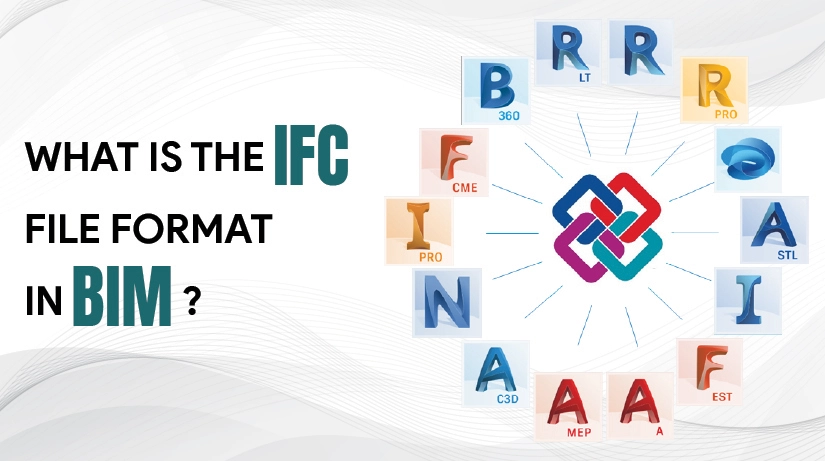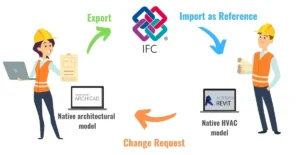What is the IFC File Format in BIM?
Feb 09, 2024
Category: Software & Tools
Admin

Have you ever heard of the IFC file format? Many believe that construction sectors need to catch up to other businesses in technology and operations. There is a need to improve the connectivity and integration of people, information, processes, and systems.
Thus, it can be difficult to transfer data directly across BIM models that different stakeholders use. There comes the role of the IFC file format. IFC is an open standard that would act as the basis for stakeholder communication and BIM data exchange processes.
BIM requires specific solutions from each program developer. This takes time to simply shift models and information between software. Thus, a common language for data communication is necessary.
Understanding IFC (Industry Foundation Classes)

The Industry Foundation Classes, or IFC, are a specific type of data format. It aims to facilitate the exchange of information models between different systems. This furthermore aids in no data loss or distortion. IFC promotes interoperability between many operators. It is an open file format that is neutral and not governed by certain software companies.
Moreover, IFC handles the data model of a building at every stage of its life cycle. The cycle can be from feasibility to realization and upkeep. This also includes other stages such as design and planning. BuildingSMART introduced the IFC file and its standard.
Thus, this aims to provide a globally standardized tool. The tool could assist and monitor construction progress and the life cycle of buildings. Hence, IFC in BIM is standard in the AEC (Architect, Engineering, and Construction) industry.
Understanding BIM (Building Information Model)
Building information modeling (BIM) is the process of creating and managing digital representations. This aims at the place’s functional and physical attributes. Several tools, technologies, and standards facilitate it. Building information models, are computer files that aid in extracting, sharing, or networking. This further helps in decision-making.
The files are frequently, but not always, in proprietary formats. This also contains proprietary data. People who develop, design, build, run, and manage buildings and various physical infrastructures use BIM software.
Physical infrastructures may include water, waste, electricity, communication channels, gas, roads, and more. Experts in the fields of architecture, engineering, and construction (AEC) use BIM procedures and tools. This helps to make informed decisions.
Importance Of Interoperability
BIM is more than simply ‘technology’, it may be the advancement in the sharing of digital information that is giving the momentum missing in past construction industry efforts. Regardless of the software programme or BIM platform, the industry needs a reliable mechanism to interchange the ever-increasing amounts of digital data to realize BIM’s full potential.
There are two methods you can take on the problem.
● You could choose to use proprietary product(s) from a certain company to deliver the work you do, or you could use open file formats for delivering files.
● Choosing a vendor who holds a specific amount of market share will probably result in a collection of related items.
Thus, these with minor adjustments, will produce the desired results. Other members of the project team may have access to your files more easily because they use the same tools. People who aren’t will probably be able to convert files while keeping all or most of the data in them. They can utilize these resources in the systems that run their business processes.
If you make a significant investment in a vendor’s file formats, it might be a problem then. Other members of the project team may have access to your files more easily because they use the same tools.
If you choose openBIM as an alternative, you can import data into the tool(s) of your choice and share data easily. If development deviates even farther from your requirements, it may be difficult to cut loose and migrate data. Thus, using an IFC file format can make your work much easier.
| Also Read: 10 Amazing Revit Plugins You Should Know
Usage of IFC File Format In BIM
Nowadays, the IFC file format commonly facilitates data transactions in models by transferring information across project participants. An architect might, for instance, give a building model to an owner who then sends it to a contractor for a quote. The contractor might then give the owner an as-built model that includes information about the manufacturer and installed equipment.

The needed IFC file format data can be encoded in a variety of forms, including XML, JSON, and STEP, then delivered via imported/exported files, web services, or managed in centralized or linked databases.
In addition to model authoring, simulation, design and analysis, viewing, and more, the CAD/BIM authorship software platform providers will give end users interfaces for exporting, importing, and transmitting data in the IFC file format. Users can choose what information from their tools they wish to share through the IFC file format. It is convenient to use a BuildingSMART-certified platform for IFC data exchange.
What is the importance of IFC in BIM?
IFC plays important roles within the context of BIM which are as follows:
Standard File Format
Building design and construction involve a variety of technical responsibilities. Each of these responsibilities works within their specific areas of competence. This highlights its importance from a strategic viewpoint for all involved parties. This aids in communicating information to work together efficiently. Also, it helps in the implementation and operation of a project.
Thus, this is the primary reason that a standard file format is essential for the exchange of a multidisciplinary data model. This enables safe data exchange and interoperability. Also, IFC guarantees no mistakes or data loss. This is the primary reason why adopting IFC in BIM is essential.
Enhance Project Interoperability
Additionally, for working on the project, each stakeholder can use their software. The IFC file format ensures that everyone is using the same sets of data. Moreover, IFC reduces the possibility of errors and miscommunications in big projects with several stakeholders.
Additionally, implementing the IFC file format is crucial considering it is more interoperable. This makes it simpler for users to share files with others. This is because an IFC file format makes accessing and updating easier in BIM authoring platforms.
Promotes Data Integrity
By facilitating data integrity, IFC reduces errors and redundancies and ensures correct and reliable information flow. IFC in BIM maintains data integrity throughout information sharing to ensure that important details about the building model, such as construction, materials, and relationships, are reliable.
Enhanced sustainability
The IFC file format contains information about a building’s materials, energy consumption, and environmental impact. With this knowledge, more environmentally friendly and energy-efficient building designs and constructions are made. Furthermore, the IFC file format makes it possible to monitor a building’s performance over time and make continuous changes.
| Read More: Top 7 Benefits of Autodesk Navisworks
Conclusion
IFC is the BIM framework. BIM makes Smart Cities and smart asset management possible. Both proprietary as well as open-source software programs support IFC files. They are crucial for sharing information in BIM. Architects, capital project investors, engineers, construction companies, and asset managers thus use this. By implementing IFC in BIM, This will save a significant amount of time and money.
About TechnoStruct Academy:
TechnoStruct Academy is the educational arm of TechnoStruct, LLC, a registered design engineering firm based in California. It offers specialized BIM training programs for architecture, MEP, and BIM Management.
Our BIM Certification Courses:
BIM-Ready+: Become a BIM Management professional specialized in managing all ASMEPF projects working with open BIM and interoperability with a credible BIM Manager Certification.
BIM-Ready Complete: Become a BIM Engineer specialized in all ASMEPF (Architectural, Structural, Mechanical, Electrical, Plumbing, and Fire Protection) disciplines working with open BIM and interoperability.
BIM-Ready (Arch+Structure): Specialize in BIM Fundamentals, Conceptual Design, Sustainable Design, Design Development, and Construction Documentation in the BIM Environment with this BIM Architect Course.
BIM-Ready (MEP): Become an MEP BIM Engineer specializing in BIM Fundamentals, HVAC, Electrical, Plumbing and Fire Fighting, Design, and Modeling in a BIM Environment.
Bexel Manager Certification Program: This program teaches you about BEXEL Manager, a software that brings together key 3D, 4D, 5D, and BIM features, making it quick and easy to embrace BIM processes and technology for speedy project implementation.








